Fourteen days after the Chinese New Year, the PengHu islanders offer sacrificial images of sea turtles to their temple deities to ensure peace, prosperity, and good fortune. These rituals of devotion last for three days as part of the Lantern Festival -- the most important celebration of the Lunar New Year in PengHu. During this time, the temples are crowded day and night with worshippers burning incense and praying for favors and divine guidance. Others are there to show appreciation for wishes granted the previous year. Rice cakes made into all shapes and sizes of sea turtles are the most common items placed in the temples as sacrifice. Other offerings include turtle images fashioned from gold and coins. The PengHu people believe that the sea turtle is an auspicious creature, blessed with good luck and long life. Ling (1972), writing in Chinese, has drawn comparisons between the PengHu ceremonies and the ancient Polynesian practice of sacrificing and feasting upon sea turtles at stone altars in the remote Tuamotu Islands (Emory 1947). Sea turtles nest in PengHu, but presently only in small numbers mainly on the island of WanAn (Chen and Cheng 1995). Satellite tracking has recently shown that seasonal migrations to this location occur from several distant foraging areas, including Hainan, Hong Kong, China, Okinawa and southern Japan (Cheng and Balazs 1998). Real turtles are not sacrificed during the PengHu ceremonies, although Ling (1972) speculates that they probably were used for this purpose in the distant past (see also Allan 1991).
The Islands and the People- PengHu, called Pescadores (Fishermen Islands) by early Portuguese explorers, consists of 64 small coral and basalt islands located in the Taiwan Strait at 23.5 degrees North, 119.5 degrees East, about 100 km south of Fukien province in China and 60 km west of Taiwan. The area is a dividing point between the East and South China Seas characterized by hot summers, cold winters, and strong northeast monsoons. Immigrants first came to PengHu from Fukien over 800 years ago, or 400 years earlier than the settlement of Taiwan by the Han Chinese. The traditions, beliefs, and language of the PengHu people have retained some of their own identity as the result of geographical isolation. There are about 96,000 residents in 97 villages located on the 20 inhabited islands. Most people live on the main island (PengHu) in or around the modern city of Makung. At last count, there were 174 community temples dedicated to various Gods. Thousands of other small temples or shrines exist in homes and businesses throughout PengHu for personal family worship. The PengHu folk religion is a blend of Chinese Taoism, Buddhism and complex supernatural concepts not easily understood within Western thought or language. Community temples are architecturally intricate, visually stunning, and costly. The roofs are particularly striking, rising upward in peaks that support ceramic figures of Gods, dragons, and other mystical beasts. Another prominent feature seen nearly everywhere throughout the PengHu landscape is the walled cement graves of ancestors adorned with colored tiles. The following quote from a tourist guidebook exemplifies the religious fervor of the people: "PengHu is an oceanic country. Most of the residents live by fishing. PengHu's coastline is very long and most of the residents live on the sea, so they have to face the challenge of evil waves. Facing the changeable nature, it is more violently required for them to pray to Gods. So they respect heaven and earth and are afraid of Ghosts and Gods. Due to this factor, the density of temples in PengHu is the number one in Taiwan, and the temples are very luxurious. When you travel here, it seems you are in paradise. She is the hometown of the sea, a pretty archipelago, the 'Hawaii' of Taiwan."
Ma-tsu the Sea Goddess- There is a special relationship with the deity, Ma-tsu, and the turtle sacrifice ceremonies of PengHu. The coastal people of the China region, and especially Taiwan, have a deep and widespread devotion to the Goddess Ma-tsu as the guardian of fishermen, ocean travelers and all who live near the sea. In Taiwan, many consider her to be their "Patron Saint." Ma-tsu was born with auspicious signs on Meichou Island, Fukien on the 23rd day of the third moon in 960CE. As a pious young girl named Mo-Lin, she was given special charms and insights by Taoist Masters. Later she used supernatural powers to save her father and brothers when their boat capsized. Other stories were told of her merciful intervention. When she died in 987CE, a temple was built in her village to attract continuing favors. Word of her miracles spread throughout the region and, by imperial decrees issued during the following centuries, she received imposing high titles, including Tien Hou (Consort of Heaven). This is the name she is commonly called in the vicinity of Hong Kong. When immigrants came to PengHu from Fukien, they built a temple for Ma-tsu in honor of the protection and safe navigation the Goddess gave during the ocean voyage. Today, throughout China and Southeast Asia, there are an estimated 5000 temples dedicated to Ma-tsu, with more than 200 million followers that believe in her protective powers (see for example http://www.kuantu.org.tw).
A Visit to Five Temples- On February 11-12, during the 1998 Lantern Festival, we visited PengHu as the guests of local officials to observe, photograph and learn about the turtle sacrifice ceremonies. We (the three authors) were accompanied by our friends, Jeff Chen and Louise Shen of Rationalism Production House in Taipei. The interest in making such a trip first arose in the 1970's, when Shun-Sheng Ling sent GHB a copy of his report on turtle sacrifice (Ling 1972). Five temples were visited, one after the other, during a 10-hour period extending from mid-afternoon to the early morning of the next day. It should be noted that the temples are the "official residences" or %uFFFDpalaces%uFFFD of the Gods, rather than gathering places for congregations. Hence a memorable feature of this trip was the genuine acceptance and hospitality by the PengHu people of our presence in the temples. Short descriptions of the five temples visited are as follows:
- Ocean Spirit Temple-
- This temple was remarkable for the large number of stylized and colorfully decorated rice cake turtles arranged row after row on tables throughout the temple. When a turtle was purchased, as an offering, from the temple priest it was turned around so the head faced the deity. A paper sign was then placed on the turtle with the worshippers name and request written on it for the God to see. For example, one such request asked for "happiness, handsome salary, long life and joy."
- Tien Hou Ma-tsu Temple-
- Built in 1592, this is the oldest existing Ma-tsu temple in PengHu and all of Taiwan. The original structure is located behind the present modern temple building containing the Ma-tsu deity. A sea turtle fashioned from bags of rice flour totaling 6000-kg was present inside the main entrance. This huge turtle, with decorative flashing lights, was surrounded by a wishing-pond where coins were tossed as offerings. A golden-robed figure of Ma-tsu stood upon the turtle's back. Boiled eggs dyed various colors were presented by women attendants who warmly welcomed all who entered. The priests gave worshippers pouches of silk cloth containing incense ashes from the temple. Finely embroidered Chinese characters on these 'peace and protection' amulets proclaimed "The Heavenly Queen's Palace in PengHu." A plaque in the original temple building illustrated the ocean path taken across the Taiwan Strait when the Ma-tsu deity was first brought from Fukien to PengHu. We noted that this route was similar to the one taken by some of the migrant turtles tracked by satellite from PengHu. Sticks of incense commonly placed on the backs of the rice cake turtles, with smoke rising symbolically to the heavens, reminded us of the transmitter antennas on migrating turtles sending electronic messages skyward to satellites.
- Golden Turtle Temple-
- Located at Shantsuei village, the sacrificial centerpiece of this temple was a 3.3 kg pure gold sea turtle, mechanically "swimming" in a pond formed within the back of a large concrete turtle painted gold. When a brilliant red cloth was drawn back during formal unveiling ceremonies, the Golden Turtle rose to the surface to start life-like flipper strokes and head movements in rhythm with recorded temple music. The same music and appearance of the turtle from beneath the water was repeated every several minutes, to the delight of all present. Live goldfish and small freshwater turtles swam in the pond with the Golden Turtle. Young women stylishly dressed in fine clothes, as almost everyone seemed to be for the ceremonies, greeted us at the temple entrance with smiles and gifts of small rice cake turtles. As was seen at all the temples visited, two crescent-shaped pieces of wood were dropped three times by worshippers asking for the divine favors. The orientation (up or down) of the pieces on the ground determined if the wish would be granted. In addition, if the correct sequence resulted, the person might be allowed to keep the Golden Turtle, or other precious sacrificial items, for a year. Great wealth and other good fortune were said to result from such an outcome. Outside, in the temple courtyard, there was a carnival-like atmosphere that included live entertainment, food vendors, children at play, and merchants selling all sorts of items.
- Fishing Boat Temple-
- Located at Waian Village, this setting consisted of a large cement courtyard with two small temples side-by-side. We arrived late at night, but could see the sky brilliantly illuminated from miles away by the lights of squid fishing boats berthed in the harbor. Aerial fireworks from the boats, and massive strings of firecrackers in the courtyard, were periodically ignited during our visit. The throng of worshippers both inside and outside the temples caused us to blend into the crowd, seemingly unnoticed by local residents. Although GHB was the only Westerner known to be present here, and at the other four temples visited, no one seemed to pay much attention to this anomaly, except with smiles and other gestures of friendship. The remarkable ceremonies seen at Waian included a ritual of the deity leaving its temple image and entering a human "God representative." Once taken over by the God, this special person was carried by litter around the village. This short procession was followed by more lengthy rituals of unusual ancient chants, music and dance to coax the God to come out of the person and return to the temple idol. Most of these ceremonies occurred inside the temple. In sharp contrast, at the same time modern entertainment took place in the courtyard involving stage shows with singing, dancing, and the awarding of raffle prizes.
- Gold Temple-
- Located near Makung Harbor, this splendid temple, replete with luxurious ceiling and wall carvings and gold inlay, had only recently been built at a reported (but very believable) cost of US$35 million. Numerous pure gold sea turtles from 2-30 cm in length, housed in glass cases, were positioned around the deity. Also notable in this temple was an attractive 180-kg rice cake turtle with a colorful tiger design on its back.
Turtle Sacrifice at the Nineteenth Annual Sea Turtle Symposium- The day this paper was presented at the Nineteenth Annual Symposium in Texas coincided with the 1999 turtle sacrifice ceremonies in PengHu, taking place half-way around the world. To provide realism, the talk was given in the presence of a small temple altar complete with an image of Ma-tsu that included ceremonial red lights, candles, paper money and an electric (non-smoking) incense blazer. Rice cake turtles, hand carried a few days earlier from PengHu by I-JC and H-CW, were also on display. Souvenir pictures of the 6000-kg rice flour turtle were distributed. The numerous photographs shown of the 1998 visit to PengHu, as part of the Symposium presentation, will appear on a website created for this purpose.
The ultimate message we want to convey in this paper is that, globally, the cultural heritage relating to sea turtles is diverse, deep and significant. More information of this nature needs to be uncovered, presented at symposia, published in the literature, and ultimately used to integrate appropriate conservation practices in line with local customs and beliefs. The presentation at the symposium closed with the following reading from an essay by Lyall Watson (Lindsay 1995):
"We are the pattern-makers, the watchers of the world, sorting through the entrails of the earth in an endless search for meaning. It has always been this way, as though consciousness carries with it the penalty of a pressing need to know. So we look for signs in everything, reading nature like a book, hoping always to come across some sort of message hidden between the lines. Some clue, some hint of direction, anything that will make it easier to understand who we are and what on earth we should be doing. There are no easy answers."
Literature Cited
Allan, S. 1991. The shape of the turtle: myth, art and cosmos in early China. State University of New York Press, Albany, NY, 230p.
Chen, T.H. and Cheng, I. 1995. The breeding biology of the green turtle, Chelonia mydas (Reptilia: Cheloniidae) at WanAn Island, Peng-Hu Archipelago, Taiwan. I. Nesting ecology. Marine Biology 124:9-15.
Cheng, I.-J. and G.H. Balazs. 1998. The post-nesting long range migrations of the green turtles that nest at Wan-An Island, PengHu Archipelago, Taiwan. Proceedings of the 17th Annual Sea Turtle Symposium, 4-8 March 1997, Orlando, Florida. US Dep.Commer. NOAA Tech. Memo. NMFS-SEFSC-415, 29-32.
Emory, K.P. 1947. Tuamotuan religious structures and ceremonies. Bernice P. Bishop Museum Bulletin 191, 103p.
Lindsay, C. 1995. Turtle islands: Balinese ritual and the green turtle. Essay by Lyall Watson. Takarajima Books Inc. N.Y., 121p.
Ling, Shun-Sheng. 1972. Turtle sacrifice in China and Oceania. Institute of Ethnology, Academia Sinica, Monograph No. 20 (in Chinese), Nankang, Taipei, Taiwan ROC, 122p.
Thompson, L. G. 1995. Chinese religion. Wadsworth Publishing Co., Belmont, Calif. 182

Image of Ma-tsu on her temple altar with pure gold sea turtles and other precious sacrificial offerings.


I-Jiunn Cheng and plaque showing the ocean pathway taken by Ma-tsu across the Taiwan Strait from Fukien, China to PengHu.


I-Jiunn Cheng and George Balazs at the Nineteenth Annual Sea TurtleSymposium held in Texas during March 1999. The beautiful sacrificialsea turtles made of rice cake were hand carried fresh from Taiwan byCheng and Wang especially for the symposium presentation.



The small temple altar dedicated to the Sea Goddess Ma-tsu at theNineteenth Annual Sea Turtle Symposium. The traditional incense burnercontained electrically illuminated smokeless incense. Fruit, seaturtle rice cakes, and stacks of paper money were placed as offerings.



 
Two of the altars in the magnificent Ma-tsu Temple located at Kuandu,Taiwan.

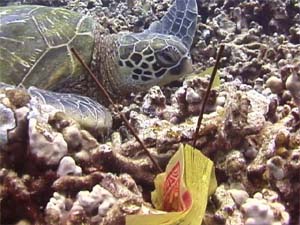
PengHu sea turtle sacrifice- Unusual underwater offering of paper moneyand incense to a living turtle.


I-Jiunn Cheng and George Balazs burning paper-money as ancestral offerings at the Ocean Spirit Temple.


PengHu sea turtle sacrifice- Image of Ma-tsu from Taiwan temple on theback of a mother turtle laying eggs.


Tien Hou Ma-tsu Temple, built in 1592, is the oldest existing Ma-tsu Temple in PengHu and all of Taiwan.


PengHu people celebrating at Tien Hou Ma-tsu Temple, February 26, 2002.



George Balazs at Tien Hou Ma-tsu Temple, PengHu, February 26, 2002 (Photo by Hsuanfen Cheng).



-Jiunn, Jeff, Louise, Chien-Chien, and George at Taipei City Airport, February 27, 2002.

 |

Beautiful ceramic images that comprise temple roofs in PengHu and Taiwan.


Sacrificial sea turtle fashioned from coins.


Giant sea turtle fashioned from 6000 kg of rice flour located inside %uFFFDThe Heavenly Queen%uFFFDs Palace%uFFFD in PengHu. An image of the Sea Goddess Ma-tsu stands on the turtle%uFFFDs back.


Map of the PengHu Islands in the Taiwan Strait.


Small image of Ma-tsu located outside the Tien Hou Ma-tsu Temple.


Visitors to the Turtle Sacrifice Ceremonies in the PengHu Islands on February 11-12, 1998. From left to right: PengHu County official- our gracious host, Hui-Chen Wang; Louise Shen, I-Jiunn Cheng and George Balazs.



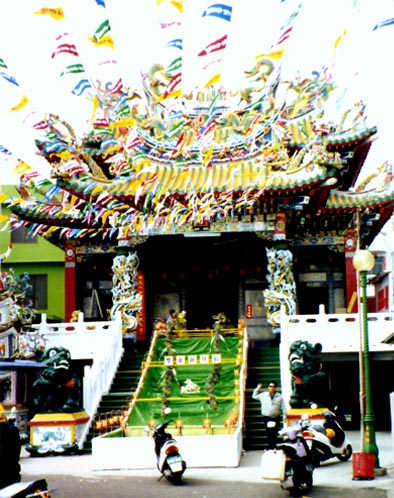
Ocean Spirit Temple in PengHu.

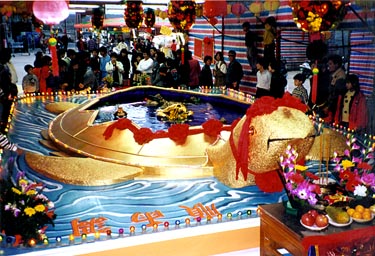
Courtyard of Golden Turtle Temple at Shantsuei Village.


Golden Turtle Temple at Shantsusei Village,PengHu. A 3.3 kg pure gold robotic sea turtle swims in a pool of water in the back of a large golden-painted turtle adorned with red ribbon.


Hui-Chen Wang and George Balazs on the steps of Fishing Boat Temple.

Rice cake sea turtle weighing 180 kg offered as sacrifice.


Sacrificial offerings at Fishing Boat Temple, Waian Village.

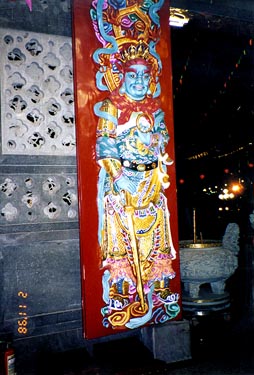
Guardian image on the entrance door of Gold Temple located near Makung Harbor, PengHu.

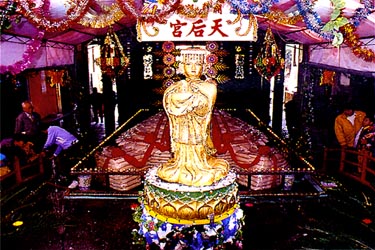
Image of Ma-tsu in front of a large sea turtle fashioned from rice flour.

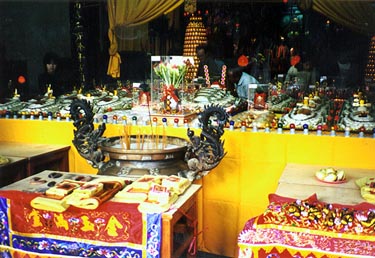
Incense burner at temple altar along with numerous sacrificial offerings.


Close-up of plaque at Tien Hou Ma-tsu Temple.


Rice cake turtles offered as sacrifice at the Ocean Spirit Temple.


George Balazs and I-Jiunn Cheng at North Pole Temple, PengHu, February 26, 2002.


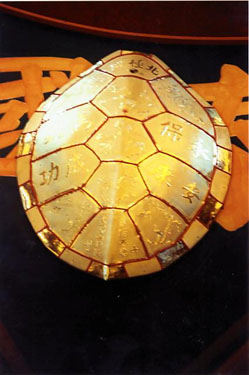
Gold Turtle Shell at North Pole Temple, PengHu, February 26, 2002.


Year of the Horse: Gold turtles displayed on miniature railway in front of Golden Turtle Temple, PengHu, February 26, 2002.



Another view of gold turtles at Golden Turtle Temple, PengHu, February 26, 2002.



PengHu people celebrating at Golden Turtle Temple, February 26, 2002.



First full moon of the Chinese New Year (Year of the Horse), PengHu, February 26, 2002.

 |



